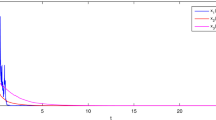Summary
A simple mathematical model was proposed to describe the dynamics of a food-consumer system. The model was based on the Logistic Theory and consisted of Eqs. (4), (5) and (6). The model was divided into the following three cases for further analyss; i) without food supply except at the initial time, ii) with continuous food supply at a constant rate, and iii) with food supply at varying rates. Only the first model was dealth with in this paper.
The assumptions of the model 1 are that a definite amount of food is given only once at the initial time and only the feeding by animals is responsible for the decrease of food, and that the rate of decrease is proportional to the amount of animals. It is also assumed that the growth of animal population is represented by the logistic curve, and that the upper limit of the population is proportional to the amount of food at that time. For simplicity the parameters of basic differential equations are assumed to be constant throughout the time course.
Analytical solutions of this non-linear model were given by Eqs. (8), (9), (10) and (11). The properties of time course of the food amount and consumer population were discussed from the mathematical and biological points of view. The method of the estimation of the three constants λ,b, andc from the experimental data was also suggested.
Since we had no available data for animal populations, we applied the model, regarding reserve substance asx and new plant body asy, to the data of the initial growth of Azuki bean plant in the dark.
This model is very simple, but it may be useful for analyzing the behavior of food-consumer system. And it may give some clue to the analysis of the more complex systems.
Similar content being viewed by others
References
Gause, G. F. (1934)The struggle for existence. Williams & Wilkins, Baltimore.
Lotka, A. J. (1925)Elements of physical biology. Williams & Wilkins, Baltimore, reprinted asElements of mathematical biology, Dover, 1956.
Shinozaki, K. (1953) On the generalization of the logistic curve III. Population curves of Japanese.J. Osaka City Medical Center 2: 265–272. (In Japanese)
Shinozaki, K. andT. Kira (1956) Interspecific competition among higher plants VII. Logistic theory of the C-D effect.J. Inst. Polytech. Osaka City Univ. D7: 35–72.
Shinozaki, K. andT. Kira (1958) On the growth curves. In:Modern biology series (Kyoritsu Publ. Co., Tokyo) 6, pp. 1–24. (In Japanese)
Shinozaki, K. (1967) The improvement ofLotka-Volterra’s equation.Proc. Ann. Meet. Ecol. Soc. Jap. (Matsuyama): 77. (In Japanese)
Utida, S. (1950) On the equilibrium state of the interacting population of an insect and its parasite.Ecol. 31: 165–175.
Author information
Authors and Affiliations
Rights and permissions
About this article
Cite this article
Ishihara, M., Hozumi, K. & Shinozaki, K. A mathematical model of the food-consumer system I. A case without food replenishment. Res Popul Ecol 13, 114–126 (1972). https://doi.org/10.1007/BF02521972
Issue Date:
DOI: https://doi.org/10.1007/BF02521972




